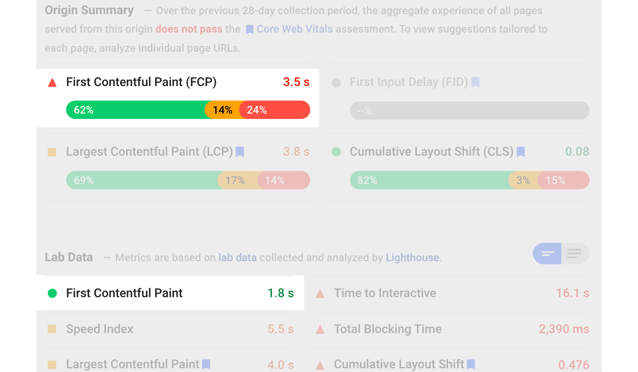.jpg?width=640&name=igor-miske-JVSgcV8_vb4-unsplash%20(1).jpg)
A quick loading time is a must-have for any website. A website that takes a long time to load has a higher likelihood of being abandoned by users. Every website is different in terms of loading time and performance, and complicated websites take longer to load than simple ones.
Several metrics can be used to evaluate the speed of your site to improve its performance and user experience — one of these metrics is the First Contentful Paint (FCP). FCP, which accounts for 10% of a site's total performance score, is essential in ensuring that visitors have a good experience. Keep reading to learn more about First Contentful Paint and why your site should be optimized for it.
What Is First Contentful Paint?
First Contentful Paint (FCP) is one of the Core Web Vital performance indicators that measure users' perception of a website's performance. These measurements are crucial for providing quick user experiences and minimizing SEO performance penalties.
FCP measures how long it takes a webpage to render its first element from the perspective of the website's users. Since the FCP is the first thing visitors see when the page loads, achieving a quick FCP is essential for making a positive first impression.
FCP should be kept low so that users can see some of the website's elements rendering quickly after loading the page. Visitors will spend more time on your site if your FCP score is better. Because of this, your website users will have a better overall experience and won't leave your website in frustration because the page isn't loading correctly.
First Contentful Paint vs Largest Contentful Paint
Though the two terms sound similar, they are two different metrics. Largest Contentful Paint (LCP) gauges how long it takes for a website's largest element to become visible. FCP, on the other hand, takes into account the first object to load, which is often not the largest.
What Is a Good First Contentful Paint?
It's crucial to understand what a good FCP score is before assessing your site's First Contentful Paint. Your goal should be to keep your FCP time at 1.8 seconds or less. If your FCP score is between 1.8 and 3.0 seconds, your website's elements need to be improved. On the other hand, if your FCP time is longer than 3.0 seconds, you have a problem that must be addressed immediately.
You'll be able to see if your website requires improvement if you have a better idea of what your site's FCP speeds should be.

How To Measure the First Contentful Paint
FCP can be measured using both lab testing (pre-release) and field tools (real-world users).
While measuring FCP in the lab is a helpful technique to iron out bugs before going live, it isn't the most reliable approach to assess performance. Fortunately, field testing can show you how users interact with your website when using different types of devices, networks, and software.
Here are some tools you can use to measure FCP:
Lab Tools
- Lighthouse
- Chrome DevTools
- PageSpeed Insights
Field Tools
- PageSpeed Insights
- Chrome User Experience Report
- Search Console (Speed Report)
- web-vitals JavaScript library
How To Improve First Contentful Paint
Improving your FCP score isn't always straightforward. However, prioritizing the errors that have the most significant impact becomes more manageable with the correct strategy. Here's how you can get started:
List Down Significant Problem Areas
Performing lab and field tests will help you determine precisely what needs to be worked on to improve your site's FCP score. After discovering the main problems with your site's FCP, you'll know what needs to be fixed and where to focus your efforts.
Resolve Issues With the Assistance of Your Web Team
It's just a matter of implementing measures to address the problems that affect FCP if you know what to look out for. To give you an idea, here are some usual methods for improving FCP:
- Activating website caching
- Using a faster server
- Removing render-blocking resources
- Preloading essential resources
- Not lazy loading images above the fold
- The Bottomline
It's essential to have a fast-loading website these days if you want to keep your visitors. One way of doing this is by improving your FCP score. With a quicker FCP, your users will have a better experience, and your page's overall performance will be better, too. Need help improving your website's FCP? Contact Connection Model and let us help you optimize your digital marketing efforts.
Written By: David Carpenter


